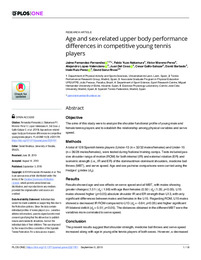Por favor, use este identificador para citar o enlazar este ítem:
https://hdl.handle.net/11000/30726Registro completo de metadatos
| Campo DC | Valor | Lengua/Idioma |
|---|---|---|
| dc.contributor.author | Fernández-Fernandez, Jaime | - |
| dc.contributor.author | Nakamura, Fábio Yuzo | - |
| dc.contributor.author | Moreno Pérez, Víctor | - |
| dc.contributor.author | López-Valenciano, Alejandro | - |
| dc.contributor.author | Del Coso, Juan | - |
| dc.contributor.author | Gallo-Salazar, Cesar | - |
| dc.contributor.author | Barbado, David | - |
| dc.contributor.author | Ruiz-Perez, Iñaki | - |
| dc.contributor.author | Sanz-Rivas, David | - |
| dc.contributor.other | Departamentos de la UMH::Patología y Cirugía | es_ES |
| dc.date.accessioned | 2024-01-26T10:36:40Z | - |
| dc.date.available | 2024-01-26T10:36:40Z | - |
| dc.date.created | 2019-09-03 | - |
| dc.identifier.citation | PLoS ONE 14(9): e0221761 | es_ES |
| dc.identifier.issn | 1932-6203 | - |
| dc.identifier.uri | https://hdl.handle.net/11000/30726 | - |
| dc.description.abstract | Objective The aims of this study were to analyze the shoulder functional profile of young male and female tennis players and to establish the relationship among physical variables and serve speed. Methods A total of 128 Spanish tennis players (Under-13 (n = 32/32 males/females) and Under-15 (n = 36/28 males/females), were tested during National training camps. Tests included passive shoulder range of motion (ROM) for both internal (IR) and external rotation (ER) and isometric strength (i.e., IR and ER) of the dominant/non-dominant shoulders, medicine ball throws (MBT), and serve speed. Age and sex pairwise comparisons were carried using the Hedges’ g index (dg). Results Results showed age and sex effects on serve speed and all MBT, with males showing greater changes (1.51�dg�1.98) with age than females (0.92�dg�1.35; p<0.05). U15 males showed higher (p<0.05) absolute shoulder IR and ER strength than U13, with only significant differences between males and females in the U15. Regarding ROM, U15 males showed a decreased IR ROM compared to U13 (dg = -0.84; p<0.05) and higher significant IR bilateral deficit (dg = 0.51; p<0.05). The distances obtained in the different MBT were the variables more correlated to serve speed. Conclusion The present results suggest that shoulder strength, medicine ball throws and serve speed increased along with age in young elite tennis players of both sexes. However, a decreased range of motion and bilateral deficit for glenohumeral internal rotation is evident in male under-15 tennis players. Muscle strength, power and shoulder range of motion are key factors for serve speed in young tennis players. | es_ES |
| dc.format | application/pdf | es_ES |
| dc.format.extent | 18 | es_ES |
| dc.language.iso | eng | es_ES |
| dc.publisher | Public Library of Science | es_ES |
| dc.rights | info:eu-repo/semantics/openAccess | es_ES |
| dc.rights.uri | http://creativecommons.org/licenses/by-nc-nd/4.0/ | * |
| dc.title | Age and sex-related upper body performance differences in competitive young tennis players | es_ES |
| dc.type | info:eu-repo/semantics/article | es_ES |
| dc.relation.publisherversion | https://doi.org/10.1371/journal.pone.0221761 | es_ES |

Ver/Abrir:
Age and sex-related upper body performance.pdf
582,01 kB
Adobe PDF
Compartir:
 La licencia se describe como: Atribución-NonComercial-NoDerivada 4.0 Internacional.
La licencia se describe como: Atribución-NonComercial-NoDerivada 4.0 Internacional.
.png)